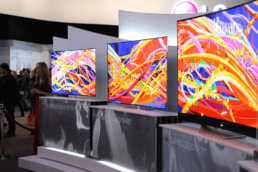OLEDS: The Next Big Thing in Televisions
OLED, or organic light-emitting diodes, televisions are shaping up to be the next big thing. In case you haven’t heard, these first debuted at CES 2013, and immediately put the spotlight on OLED.
These TVs work like no other. They run electricity through materials that light up either red, green or blue (the only colors necessary for making a television image). Currently, plasmas utilize special gasses that produce UV light and LCDs use color filters and crystals to block light in front of a backlight. LED TVs are simply LCD models that use LEDs as the backlight.
But what does this mean for consumers? These new OLED models are incredibly thin (CNET compared their depth to the width of a pencil). In addition, they’re lighter, more energy efficient and have better contrast ratios. That last one is due to every pixel on the screen having the ability to be turned off for a truly dark black.
Initially, these TVs came with a high price tag. The first generation had prices that stretched from about $9,000 to $15,000. Now, that’s changing, and more consumers will soon be able to afford the OLED technology.
LG’s entry level OLED model, the B6, has fluctuated in price between $1,800 and $2,500 over the past year. They’ve also boosted production, signaling that they expect increased sales in the future. While the higher-end models are still around $10,000, Sony announced that they will be releasing their own line of OLED TVs, which is sure to drive prices down to competitive rates. While OLEDs might still be out of reach for the masses, it’s clear that they’re here to stay, and that a revolution in TVs and their backlight is coming.
And for any television manufacturers, no matter the TV or screen, Konica Minolta Sensing has the technology to ensure your products are emitting the right lights and colors. Check out our catalog of instruments for the display industry and see our CA-410, a breakthrough in display color analysis.
Image via Flickr by Maurizio Pesce

 CA-410
CA-410








